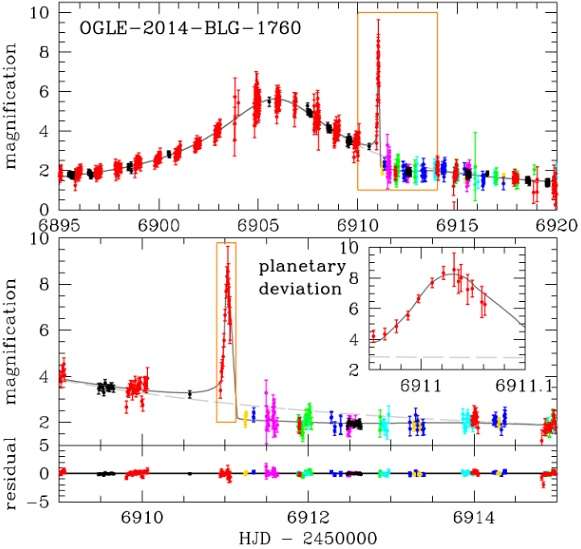March 23, 2016 report
Gas giant planet discovered near the Milky Way's bulge

(Phys.org)—Using the gravitational microlensing technique, astronomers have recently detected what appears to be a Saturn-like planet residing near the Milky Way's bulge. The newly discovered exoplanet has a mass somewhere between Saturn and Jupiter and is orbiting a star with half the mass of the sun. A paper detailing the finding was published online on Mar. 21 on the arXiv pre-print server.
If a star moves in front of an another star, the light from the distant star is bent by the gravitational pull of the nearer star and the more distant star is magnified. Microlensing does not rely on the light from the host stars; thus, it can detect planets, even when the host stars cannot be detected. This technique is very useful for detecting alien worlds in the inner galactic disk and bulge, where it is difficult to search for planets with other methods.
An international team of researchers, led by Aparna Bhattacharyaha of the University of Notre Dame used the gravitational microlensing method to detect a gas giant planet orbiting the lens stars of a microlensing event. This gravity lens, discovered in August 2014, was designated OGLE-2014-BLG-1760 and is the 1,760th microlensing event detected by the Optical Gravitational Lensing Experiment (OGLE) collaboration. OGLE is a Polish astronomical project based at the University of Warsaw, searching for dark matter and extrasolar planets. It utilizes the 1.3 meter Warsaw telescope mounted at the Las Campanas observatory in Chile.
Follow-up observations were carried out by the Microlensing Observation in Astrophysics (MOA) collaboration, the Microlensing Follow-Up Network (μFUN) and the RoboNet project. MOA uses the 1.8 meter MOA-II telescope at the Mount John Observatory at Lake Tekapo, New Zealand, while μFUN and RoboNet are global groups employing a network of telescopes worldwide.
The scientists have detected a strong light curve signal coming from OGLE-2014-BLG-1760. They assume that it must be caused by the presence of a gas giant planet.
"One unusual feature of this event is that the source star is quite blue (…). This is marginally consistent with source star in the galactic bulge, but it could possibly indicate a young source star in the far side of the disk. Assuming a bulge source, we perform a Bayesian analysis assuming a standard galactic model, and this indicates that the planetary system resides in or near the galactic bulge," the paper reads.
According to the research, the planet has a mass of about 180 Earth masses and is orbiting its parent star at a distance of approximately 1.75 AU. The host star is less massive than the sun, with a mass of some 0.51 solar masses. The lens system distance equals 22,000 light years, which suggests that the system is very likely to be in the Milky Way's bulge.
The team notes that currently the lens is too faint to be detected in high resolution images unless the lens and source are partially resolved. It is expected to occur in 2020-2022, when the source will be resolvable by the James Webb Space Telescope (JWST), the Hubble Space Telescope (HST) or adaptive optics imaging.
"Follow-up observations with JWST, HST or adaptive optics in 2020-2022 should be able to measure the lens brightness and determine the planetary mass and distance," the researchers concluded.
More information: Discovery of a Gas giant Planet in Microlensing Event OGLE-2014-BLG-1760, arXiv:1603.05677 [astro-ph.EP], arxiv.org/abs/1603.05677
Abstract
We present the analysis of the planetary microlensing event OGLE-2014-BLG-1760, which shows a strong light curve signal due to the presence of a Jupiter mass-ratio planet. One unusual feature of this event is that the source star is quite blue, with V−I=1.48±0.08. This is marginally consistent with source star in the Galactic bulge, but it could possibly indicate a young source star in the far side of the disk. Assuming a bulge source, we perform a Bayesian analysis assuming a standard Galactic model, and this indicates that the planetary system resides in or near the Galactic bulge at DL=6.9±1.1 kpc. It also indicates a host star mass of M∗=0.51±0.44M⊙, a planet mass of mp=180±110M⊕, and a projected star-planet separation of a⊥=1.7±0.3AU. The lens-source relative proper motion is μrel=6.5±1.1 mas/yr. The lens (and stellar host star) is predicted to be very faint, so it is most likely that it can detected only when the lens and source stars are partially resolved. Due to the relatively high relative proper motion, the lens and source will be resolved to about ∼46mas in 6-8 years after the peak magnification. So, by 2020 - 2022, we can hope to detect the lens star with deep, high resolution images.
Journal information: arXiv
© 2016 Phys.org



















